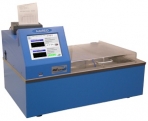- - Direct REID vapor pressure measurement
- - Perfectly suited for testing crude oil
- - Fully traceable, documented test results
- - Two independent measurement positions
- - Robust design requires little or no maintenance
- - Automation reduces operator involvement
- - Small foot print, quick warm-up, precise measurement
- - User-friendly Windows® interface
The ASTM D323, D4953, ISO 3007, IP 69 and other similar test methods cover procedure for the determination of vapor pressure of gasoline, volatile crude oil, and other volatile petroleum products, components and feedstocks. The Reid method is part of many petroleum product specifications and suitable for testing liquid samples that exert an air-saturated vapor pressure less than 180,0 kPa at 37,8 °C. Vapor pressure is an important physical property of volatile liquids. This test method is used to determine the vapor pressure at 37.8°C (100°F) of petroleum products and crude oils with initial boiling point above 0°C (32°F). Vapor pressure is critically important for both automotive and aviation gasolines, affecting starting, warm-up, and tendency to vapor lock with high operating temperatures or high altitudes. Maximum vapor pressure limits for gasoline are legally mandated in some areas as a measure of air pollution control. Vapor pressure of crude oils is of importance to the crude producer and the refiner for general handling and initial refinery treatment. Vapor pressure is also used as an indirect measure of the evaporation rate of volatile petroleum solvents. |







